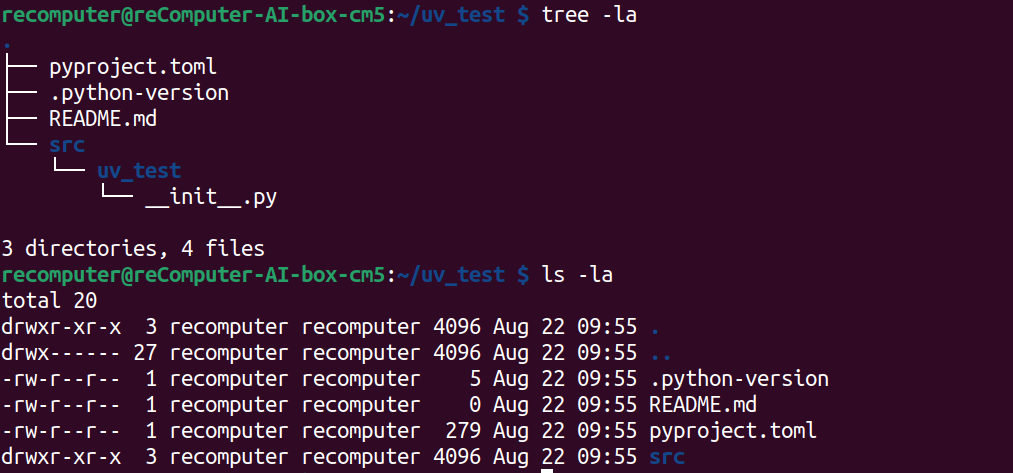Use uv on reComputer
Introduction
This wiki explains how to use the uv on reComputer box. uv is a fast, modern, and lightweight package manager and resolver for Python. It is designed to be a drop-in replacement for traditional Python package management tools like pip and pip-tools, offering significant improvements in speed, efficiency, and usability.

Prepare Hardware
| reComputer R1125 | reComputer AI R2130 | reComputer AI Industrial R2145 |
|---|---|---|
 |  |  |
| reComputer Industrial R20xx | reComputer Industrial R21xx |
|---|---|
 |  |
Prepare software
update the system
sudo date -s "$(wget -qSO- --max-redirect=0 google.com 2>&1 | grep Date: | cut -d' ' -f5-8)Z"
sudo apt update
sudo apt full-upgrade
Install uv
curl -LsSf https://astral.sh/uv/install.sh | sh
Use uv
Init the project
Here, we use uv_test as an example to demonstrate the usage of uv.
Note: Please make different project name make sure it is different from any package on PyPI.
uv init uv_test --package
cd uv_test
Check the structure of the project
ls -la
tree

Creat a python environment
Here you can creat a python environmet
uv venv
source .venv/bin/activate

Add dependencies
Use numpy to build funcation:
uv add numpy
Creat funcation
Use NumPy to write an add function on add.py as an example:
add.py
import numpy as np
def add(arr1: np.ndarray, arr2: np.ndarray) -> np.ndarray:
"""
Adds two NumPy arrays element-wise.
Parameters:
arr1 (np.ndarray): The first input array.
arr2 (np.ndarray): The second input array.
Returns:
np.ndarray: The element-wise sum of arr1 and arr2.
Raises:
ValueError: If the input arrays have different shapes and cannot be broadcasted.
"""
# Ensure that both arrays have compatible shapes for element-wise addition
try:
result = np.add(arr1, arr2)
except ValueError:
raise ValueError("Input arrays have incompatible shapes for element-wise addition.")
return result
if __name__ == "__main__":
# Example usage
arr1 = [1, 2, 3]
arr2 = [4, 5, 6]
print("Result of addition:", add(arr1, arr2))
The results are as follows:

Build the package
To build the project into a usable .whl file, modify the toml file as follow:
Build the package:
uv build
ls -a
The results are as follows:

Test the package
Install the package as below:
uv pip install dist/uv_test-0.1.0-py3-none-any.whl

Use python script to test the packag:
add.py
from uv_test.add import add
if __name__ == "__main__":
arr1 = [1, 2, 3]
arr2 = [4, 5, 6]
print("Result of addition:", add(arr1, arr2))
Push the package to PyPi
If you don't have a PyPI account, please register an account and get creat token.
uv publish
The result is like as below, and input your token:

Result
Finally, you can see your uploaded project on PyPI.

Tech Support & Product Discussion
Thank you for choosing our products! We are here to provide you with different support to ensure that your experience with our products is as smooth as possible. We offer several communication channels to cater to different preferences and needs.